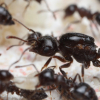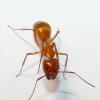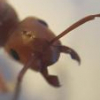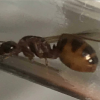- Formiculture.com
- Forums
- Gallery
- Members
- Member Map
- Chat

Wild Aphenogaster picea (I believe) colony dug up. Arlington, MA
Started By
Otter
, Jul 20 2018 5:44 PM
massachussettes
16 replies to this topic
#1
 Offline
-
Posted July 20 2018 - 5:44 PM
Offline
-
Posted July 20 2018 - 5:44 PM
I dug up a wild aphenogaster picea colony about a week ago and I noticed a strange worker in there. Upon closer inspection I found that it was a dealate queen. I have noticed smaller weird looking workers mixed in with the regular aphenogaster picea workee and I don't know if they are a different species or not. The colony started producing slates and every single slate has turned out to be this weird type. I believe them to be aphenogaster mariae but I'm not sure. Here are some not so great photos of the colony. Males are 4.5-5mm and the alate queens are roughly 5-6mm but they really don't stay still.
Here are the photos: https://imgur.com/a/zblj1Nt
Here are the photos: https://imgur.com/a/zblj1Nt
Check out my Youtube!
https://www.youtube....ohUZtcyttLctSwA
I also have an Antstagram
https://www.instagra...otters_inverts/
#2
 Offline
-
Posted July 20 2018 - 5:49 PM
Offline
-
Posted July 20 2018 - 5:49 PM
The colony was collected from underneath a rock under a tree about 30 feet from a stream. They are a darkish red-brown and are very skinny. To my eyes they look exactly like aphenogaster mariae but I wanted some other opinions
Check out my Youtube!
https://www.youtube....ohUZtcyttLctSwA
I also have an Antstagram
https://www.instagra...otters_inverts/
#3
 Offline
-
Posted July 20 2018 - 6:08 PM
Offline
-
Posted July 20 2018 - 6:08 PM
The colony was collected from underneath a rock under a tree about 30 feet from a stream. They are a darkish red-brown and are very skinny. To my eyes they look exactly like aphenogaster mariae but I wanted some other opinion
A.mariae are arboreal and not found in MA.
http://www.formicult...achusetts-only/
Youtube. https://www.youtube....Hbsk2xiarcfGTmw
Keeper of...
Aphaenogaster sp
Camponotus americanus, castaneus, chromaiodes, novaeboracensis, pennsylvanicus.
Crematogaster sp
tetramorium immigrans
Formica sp
#5
 Offline
-
Posted July 20 2018 - 7:06 PM
Offline
-
Posted July 20 2018 - 7:06 PM
I'm not sure if my eyes are deceiving me but is that Aphaenogaster and Myrmica (or Stenamma?) in the same colony? I see alates and workers of both. If so this is a very impressive find.
Edited by AntsAreUs, July 20 2018 - 7:07 PM.
- LC3 likes this
#6
 Offline
-
Posted July 20 2018 - 7:12 PM
Offline
-
Posted July 20 2018 - 7:12 PM
AntsAreUs is correct. They are cohabitating Myrmica and Aphaenogaster. There is a queen of both species.
Visit us at www.canada-ant-colony.com !
#7
 Offline
-
Posted July 20 2018 - 7:29 PM
Offline
-
Posted July 20 2018 - 7:29 PM
really? are you sure? the only reason I thought it was A. mariae is because I didn't realize aphenoghaster and myrmica could live together.
Check out my Youtube!
https://www.youtube....ohUZtcyttLctSwA
I also have an Antstagram
https://www.instagra...otters_inverts/
#8
 Offline
-
Posted July 20 2018 - 7:58 PM
Offline
-
Posted July 20 2018 - 7:58 PM
What are the species in this colony? I would love to know!
Check out my Youtube!
https://www.youtube....ohUZtcyttLctSwA
I also have an Antstagram
https://www.instagra...otters_inverts/
#9
 Offline
-
Posted July 20 2018 - 9:59 PM
Offline
-
Posted July 20 2018 - 9:59 PM
This is very interesting ![]()
Spoiler
#10
 Offline
-
Posted July 21 2018 - 4:48 AM
Offline
-
Posted July 21 2018 - 4:48 AM
It is not at all uncommon to find several species living under the same rock without them actually interacting. Now that they are thrown together the shock of being collected has likely prevented their natural animosity from being displayed. It is a good bet that given time blood will be spilled.
#11
 Offline
-
Posted July 21 2018 - 9:00 AM
Offline
-
Posted July 21 2018 - 9:00 AM
They were not living separately, they shared one cavity under the rock. I lifted it up, scooped the queen and a lot of brood out as well as all of the workers that I could find and put them in the tube. I did not collect any workers from any other pockets or chambers nearby. The myrmica workers are agressive when moving the aphenogaster males but they do not attack, only grab and move them to where they want them to be.
They were not living separately, they shared one cavity under the rock. I lifted it up, scooped the queen and a lot of brood out as well as all of the workers that I could find and put them in the tube. I did not collect any workers from any other pockets or chambers nearby. The myrmica workers are agressive when moving the aphenogaster males but they do not attack, only grab and move them to where they want them to be.
They were not living separately, they shared one cavity under the rock. I lifted it up, scooped the queen and a lot of brood out as well as all of the workers that I could find and put them in the tube. I did not collect any workers from any other pockets or chambers nearby. The myrmica workers are agressive when moving the aphenogaster males but they do not attack, only grab and move them to where they want them to be.
Check out my Youtube!
https://www.youtube....ohUZtcyttLctSwA
I also have an Antstagram
https://www.instagra...otters_inverts/
#12
 Offline
-
Posted July 21 2018 - 1:53 PM
Offline
-
Posted July 21 2018 - 1:53 PM
This is very interesting. So are these Myrmica some sort of inquilines by chance?
#13
 Offline
-
Posted July 21 2018 - 3:30 PM
Offline
-
Posted July 21 2018 - 3:30 PM
Well, we shall see.
#14
 Offline
-
Posted July 21 2018 - 3:42 PM
Offline
-
Posted July 21 2018 - 3:42 PM
I see the myrmica workers grooming the aphenogaster queen and the myrmica queen's eggs are being scooped up by the aphenogaster workers and put into their piles
Check out my Youtube!
https://www.youtube....ohUZtcyttLctSwA
I also have an Antstagram
https://www.instagra...otters_inverts/
#15
 Offline
-
Posted July 22 2018 - 3:32 PM
Offline
-
Posted July 22 2018 - 3:32 PM
Update: the aphenogaster and myrmica workers are foraging with eachother and sharing food with eachother. none of the queens have died and all are huddled in the corner with a call of workers carying eggs away. I have seen no agressive behavior from any of the ants other than agressive treatment of the male aphenogaster alates but that has come mostly from the aphenogaster workers
- Zxirl likes this
Check out my Youtube!
https://www.youtube....ohUZtcyttLctSwA
I also have an Antstagram
https://www.instagra...otters_inverts/
#16
 Offline
-
Posted July 24 2018 - 7:50 AM
Offline
-
Posted July 24 2018 - 7:50 AM
Update: the aphenogaster and myrmica workers are foraging with eachother and sharing food with eachother. none of the queens have died and all are huddled in the corner with a call of workers carying eggs away. I have seen no agressive behavior from any of the ants other than agressive treatment of the male aphenogaster alates but that has come mostly from the aphenogaster workers
Would you say there is one species that is more dominant than the other? or would you describe it as strong a co-cohabitant relationship between the two species?
- Otter likes this
Spoiler
#17
 Offline
-
Posted August 7 2018 - 4:13 PM
Offline
-
Posted August 7 2018 - 4:13 PM
Zxirl, sorry for the delayed response. I have found that the aphenogaster and myrmica queens like to hang out in the same corner and lay their eggs in the same spot. The workers of both species usually treat them as equal to their own species eggs and put them into the same pile. Depending on the day, either myrmica or aphenogaster will do most of the work. The myrmica workers are usually the ones I see in the outworld while the aphenogaster workers mainly take care of the queens and brood. If I had to choose one species that was more dominant it would be myrmica because they have more queens and workers, and tend to be a little agressive to the aphenogaster workers at first but always calm down. So far one myrmica queen has died of the three but she still had three wings so I assume that she was infertile and was just harassed by the workers. I have had 7 of 8 myrmica alates try to fly and one aphenogaster alate tried to fly. Usually this colony will eat all at once so they seem to be cooperating nicely.
- Zxirl likes this
Check out my Youtube!
https://www.youtube....ohUZtcyttLctSwA
I also have an Antstagram
https://www.instagra...otters_inverts/
1 user(s) are reading this topic
0 members, 1 guests, 0 anonymous users




















